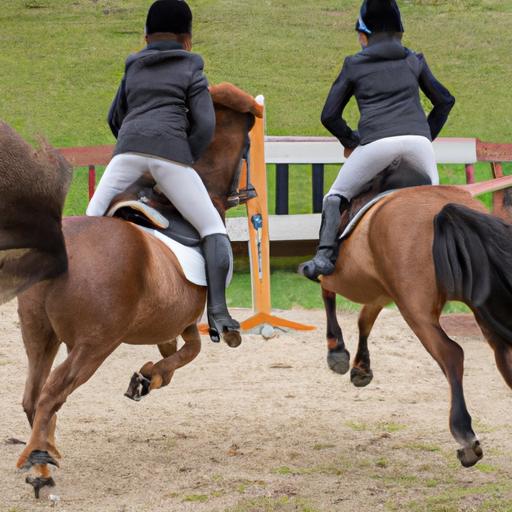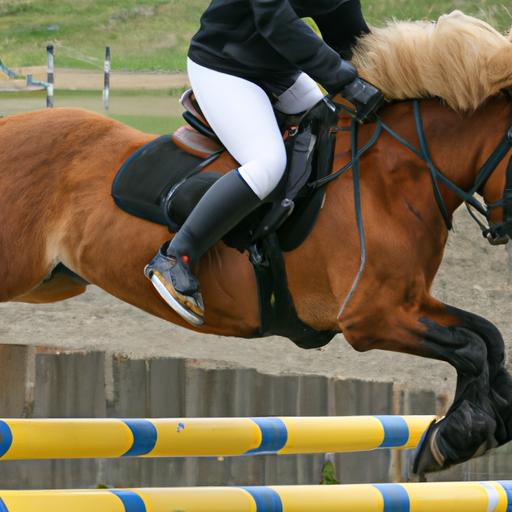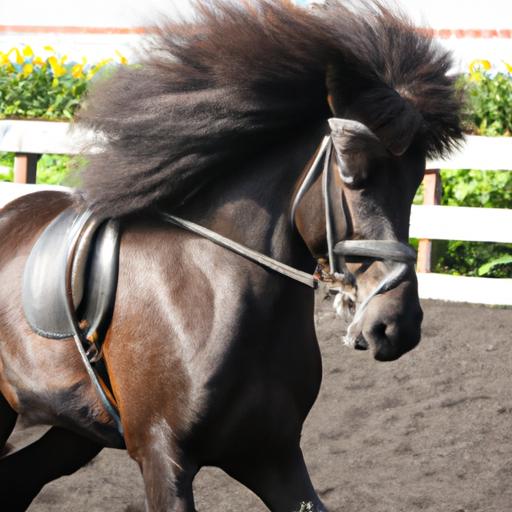Unleash the power and grace of Icelandic horses in the thrilling world of icelandic horse competitions. Explore the beauty of these remarkable equines.
Welcome to the captivating world of Icelandic horse competitions, where the grace, beauty, and skill of these majestic creatures take center stage. In this article, we will explore the thrilling realm of Icelandic horse competitions and delve into the significance of these remarkable horses in competitive events. So saddle up, and let’s embark on a journey filled with equestrian splendor.
Overview of Icelandic Horse Competitions

Icelandic horse competitions showcase the unique talents and capabilities of this extraordinary breed. Originating from Iceland, these horses possess a distinct set of abilities that set them apart from other equine breeds. Renowned for their smooth and ground-covering gait called the “tölt,” Icelandic horses captivate spectators with their elegance and versatility.
Importance of Icelandic Horses in Competition

Icelandic horses have played a pivotal role in Icelandic culture for centuries. These multi-talented equines were historically utilized for transportation, farming, and even battle. Today, they continue to be an integral part of Icelandic heritage, with competitions serving as a testament to their enduring significance.
In the realm of equestrian sports, Icelandic horses shine brightly, showcasing their exceptional qualities and captivating audiences worldwide. Their compact yet sturdy build, alongside their gentle temperament and eagerness to please, make them ideal contenders in a wide range of competitions.
Discovering the Icelandic Horse Competition
Now, let’s briefly touch upon the keyword that brought us together: “Icelandic horse competition.” This phrase encompasses the essence of our exploration, encapsulating the exhilarating events that showcase the remarkable abilities of Icelandic horses. Throughout this article, we’ll delve deeper into the intricacies of these competitions, including their history, types, training, rules, and prominent competitions worldwide.
Join me as we unravel the captivating world of Icelandic horse competitions, where the harmonious partnership between horse and rider takes center stage. Together, we will witness the magic of these extraordinary horses, their dedication, and the unbreakable bond they share with their human counterparts.
Stay tuned for the next section, where we will embark on a historical voyage, uncovering the roots of Icelandic horse competitions and their evolution over time.
History of Icelandic Horse Competitions
Origins and Traditional Use of Icelandic Horses
To truly appreciate the significance of Icelandic horse competitions, we must delve into the rich history of these remarkable creatures. The Icelandic horse, also known as the Icelandic pony, traces its lineage back over a thousand years to the Viking Age. Brought to Iceland by Norse settlers, these horses quickly adapted to the harsh Icelandic climate and terrain, forging a unique breed that has remained pure for centuries.
Initially, Icelandic horses served as indispensable companions, assisting with various tasks such as transportation, herding, and farming. Their resilience and ability to navigate challenging landscapes made them invaluable to the Icelandic people, becoming an integral part of their daily lives and culture.
Evolution of Competitions Over Time
As time progressed, the Icelandic horse’s exceptional qualities began to capture the attention of equestrian enthusiasts beyond Iceland. This sparked the evolution of Icelandic horse competitions, as the world recognized the breed’s extraordinary capabilities and sought to showcase them on a global stage.
From humble beginnings as informal local events, Icelandic horse competitions have grown into highly organized and prestigious affairs, attracting participants and spectators from around the world. These competitions serve as a testament to the enduring appeal and versatility of the Icelandic horse breed.
Development of Specific Competition Categories
As Icelandic horse competitions gained popularity, specific categories emerged to highlight the unique skills and gaits of these magnificent creatures. One of the most renowned gaits is the tölt, characterized by its smooth and four-beat rhythm. This gait, exclusive to the Icelandic horse, provides a comfortable and efficient mode of travel, making it a standout feature in competitions.
In addition to tölt, Icelandic horse competitions include categories such as four-gait and five-gait, where horses showcase their ability to perform various gaits, including walk, trot, canter, and tölt. Each category has its own set of judging criteria, allowing participants to demonstrate their horse’s versatility and mastery of specific skills.
Now that we have explored the historical roots and evolution of Icelandic horse competitions, let’s move on to the next section, where we will delve into the different types of competitions and their respective judging criteria.
Types of Icelandic Horse Competitions
When it comes to Icelandic horse competitions, there is a diverse array of categories that test the prowess and versatility of these magnificent creatures. Let’s delve into the various competition types that showcase the exceptional abilities of Icelandic horses.
1. Tölt Competition
The tölt is undoubtedly the crown jewel of Icelandic horse gaits. In this competition category, riders and their horses display their mastery of the tölt, a four-beat lateral ambling gait known for its smoothness and speed. The tölt competition emphasizes the horse’s ability to maintain a consistent rhythm, balance, and suppleness throughout the course.
2. Four-Gait and Five-Gait Competition
In these exhilarating competitions, Icelandic horses showcase their versatility by demonstrating their ability to perform additional gaits on top of the tölt. In the four-gait category, horses execute the tölt, trot, walk, and canter, while the five-gait category includes an additional gait known as the flying pace. The judges evaluate the transitions between gaits, the horse’s impulsion, balance, and overall performance to determine the winners.
Judging Criteria for Icelandic Horse Competitions
Each competition category has its own set of judging criteria that ensures a fair and comprehensive evaluation of horse and rider. The judges consider factors such as the horse’s conformation, willingness, responsiveness to the rider’s aids, and the harmony between the horse and rider. Additionally, the execution of specific movements, transitions, and overall presentation play a crucial role in determining the scores and rankings.
Notable Icelandic Horse Competitions Worldwide
Icelandic horse competitions have gained international recognition and have become a significant highlight in the equestrian calendar. Events such as the Landsmót, held in Iceland every two years, draw enthusiasts from all corners of the globe. This grand gathering showcases the finest Icelandic horses and offers a platform for riders to compete at the highest level.
Other notable competitions include the World Championships, where the best riders and horses from around the world compete for prestigious titles. These events not only celebrate the skill and dedication of the participants but also foster a sense of camaraderie and appreciation for the Icelandic horse community on a global scale.
As we continue our journey through the captivating realm of Icelandic horse competitions, the next section will shed light on the rigorous training and meticulous preparation that both horse and rider undergo to excel in these awe-inspiring events.
Training and Preparation for Icelandic Horse Competitions
Importance of Proper Training for Both Horse and Rider
In the world of Icelandic horse competitions, training plays a crucial role in ensuring success on the showgrounds. The journey towards excellence begins with the harmonious partnership between horse and rider, built on a foundation of trust, communication, and mutual understanding. Proper training not only enhances the horse’s physical capabilities but also hones the rider’s skills, resulting in a seamless collaboration during competitions.
To excel in Icelandic horse competitions, both horse and rider must undergo comprehensive training to develop the necessary skills and techniques specific to the competition categories. From tölt to four-gait and five-gait, each category requires precision and finesse, which can only be achieved through diligent training.
Techniques and Methods Used in Training Icelandic Horses
Training Icelandic horses encompasses a wide range of techniques and methods, tailored to enhance their natural abilities and showcase their unique gaits. These training methods focus on developing the horse’s balance, collection, and responsiveness to the rider’s aids.
Experienced trainers employ a variety of training tools, such as groundwork exercises, lunging, and riding drills, to refine the horse’s movements and ensure they perform at their best. The use of positive reinforcement techniques, including rewards and praise, fosters a trusting relationship between horse and trainer, creating a harmonious bond that shines through in competitions.
Dietary and Fitness Considerations for Competition Readiness
A well-rounded training program for Icelandic horse competitions goes beyond riding and encompasses proper dietary and fitness considerations. Just like athletes, Icelandic horses require a balanced diet and fitness regimen to maintain their peak performance.
A nutritionally balanced diet, tailored to the horse’s specific needs, ensures they have the energy and stamina necessary for rigorous training sessions and competitions. Additionally, a fitness routine that includes regular exercise and conditioning exercises helps build the horse’s strength, endurance, and overall fitness level.
By focusing on both training and physical well-being, horse and rider can prepare themselves adequately for the challenges that await them in Icelandic horse competitions. With meticulous training, proper nutrition, and a strong fitness foundation, they can unleash their full potential and create an unforgettable performance on the grand stage.
As we continue our exploration, the next section will delve into the rules and regulations governing Icelandic horse competitions, providing a comprehensive understanding of the guidelines that govern this captivating equestrian world.
Icelandic Horse Competition Rules and Regulations
When it comes to Icelandic horse competitions, adherence to rules and regulations ensures fair play and maintains the integrity of the sport. Let’s dive into the guidelines that govern these thrilling events, ensuring a level playing field for all participants.
Overview of the Rules and Regulations
Icelandic horse competitions follow a set of comprehensive rules and regulations that outline the criteria for judging, conduct, and safety. These guidelines are put in place to ensure consistency and fairness throughout the competition. From the moment the horse and rider enter the arena to the final moments of their performance, every aspect is meticulously evaluated based on these established standards.
Specific Requirements for Participation
To participate in Icelandic horse competitions, there are certain prerequisites that both horse and rider must meet. Firstly, the horse must be registered as an Icelandic horse and possess the necessary documentation to validate its pedigree. This ensures that only purebred Icelandic horses compete, maintaining the breed’s integrity.
Additionally, riders must meet certain age and experience requirements, depending on the competition level. Novice riders may participate in introductory categories, while more experienced riders can compete in advanced categories. These requirements help maintain safety and promote fair competition among participants of similar skill levels.
Penalties and Disqualification Criteria
In order to maintain discipline and uphold the rules, penalties and disqualification criteria are in place for any violation. Penalties may be imposed for minor infractions, such as technical errors during performances or deviations from required gaits. These penalties are reflected in the judges’ scoring and can affect the overall ranking of the horse and rider.
Serious violations or repeated offenses can lead to disqualification from the competition. Disqualification may occur if a horse exhibits signs of distress or disobedience, if a rider engages in unsportsmanlike behavior, or if there are any breaches of safety regulations. These measures ensure the welfare of the horses, the integrity of the sport, and the safety of all participants.
As we move forward in our exploration of Icelandic horse competitions, we will now shift our focus to the prominent competitions that take place worldwide. Join me in the next section as we showcase the awe-inspiring events where the best Icelandic horse riders and their remarkable steeds compete for glory.


